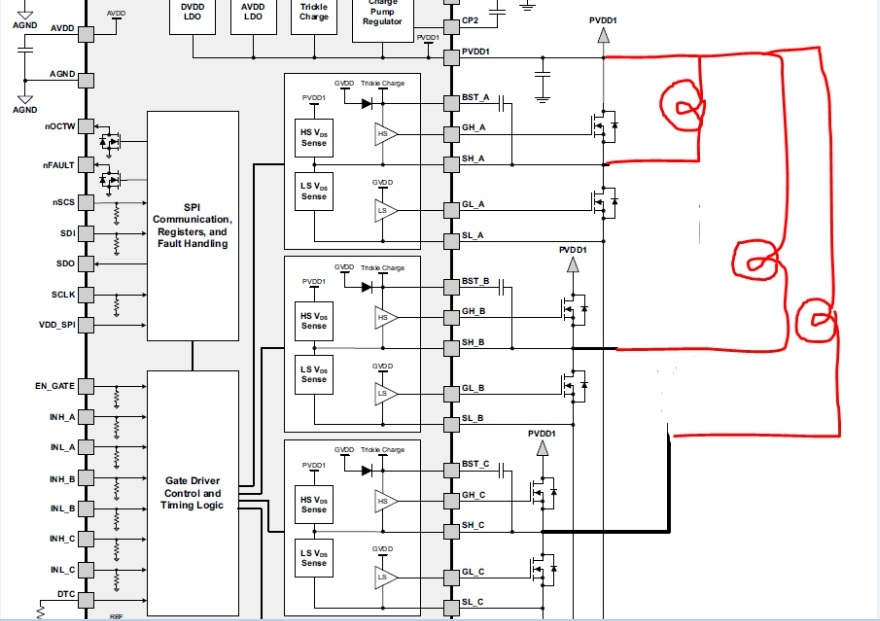Other Parts Discussed in Thread: DRV832X
My customer is seeing the following issue and I do not understand how this can be happening:
We are using the DRV8301 in our product, and recently we had a request from a customer to use the output pins as independent low-side drivers instead of half bridges. When configured in this fashion the device does not start.
The GH_x outputs are all off, and the Register configuration is as follows
g_DRV8301_0_ConfigReloadCnt 0x1
g_DRV8301_0_Control1 0x410
g_DRV8301_0_Control1_Write 0x410
g_DRV8301_0_Control2 0xC
g_DRV8301_0_Control2_Write 0xC
g_DRV8301_0_Status1 0x0
g_DRV8301_0_Status2 0x1
I have verified that the outputs work fine as an H-Bridge and as a high-side driver. I only see the reported issue when using the DRV8301 as a low-side driver. Note that I have not observed the problem when the power supply is 12V. But when the supply is 24V I can easily replicate the problem as detailed:
- Remove module from harness, wait 10 seconds
- Connect module
- Apply power
- Software enables the output (Supply is stable, EN_GATE on, Registers configured, PWM applied to LS input pin)
Note that the CPU software to drive an output as a high-side driver is identical to when driven as a low-side driver. I have found no issues when driving as a high-side.
I believe I may be seeing an unexpected silicon or firmware interaction that applies only to the low sides.
Yes, the behavior is different once the output has succeeded for the 1st time (by removing and reconnecting the load). Once this is done, the output works normally even after power cycles. The power is only removed for short periods during this test, and PVDD2 remains powered even though the rest of the module is shutdown.
Initially it was difficult for me to verify what the customer was reporting. However I can now repeat this easily. It is important that the device is run at around 24V. As 12V the issue is not seen. There was one exception: In one case I observed this at 14V.
I can also cause the issue with a simple low power LED load. The LED and current limiting resistor are connected via a toggle switch. I cause the problem by following the procedure above. There is no output on the LED. If I disconnect it using the toggle switch and then reconnect the output commences.
The values of the status registers do not change. The PWM value from the CPU is steady at all times.
The frequency and duty cycle of the PWM has no influence on this issue.
Toggling EN_GATE and re-writing the registers does not cause the output to turn on.
It does not matter how long I wait after power up before I apply PWM, the issue still occurs.
When the issue is present, reducing the supply voltage causes the output to commence. However the voltage at which it commences varies from test to test.
I agree that this does not appear logical, but can be easily repeated.
Issuing a SPI command with GATE_RESET does not restore correct operation
Could you ask the designers if there is some way that this issue could occur? Is there a work around
From the customer’s description it appears that the DRV8301 seems to lock-up and not operate until either the voltage is lowered or the load is remover and reattached. I know that there is something simple that I am missing. What could be the issue?
Please let me know if you need further information from the customer.
Thanks for your help with this!
Richard Elmquist


